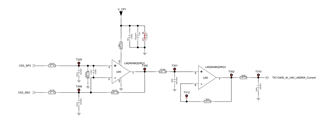Tool/software:
Hi team,
Need your help to check below problem.
V_CP1 is about 23V. This is for high side current sensing application. CS3_SP4 and CS3_SN4 are connected to a shunt resistor. When there is no current flow into the shunt. The output on T310 is about 700mV. This is extremely exceed the offset voltage of LM2904B-Q1. Could you please check this?

Thanks!
Ethan Wen


